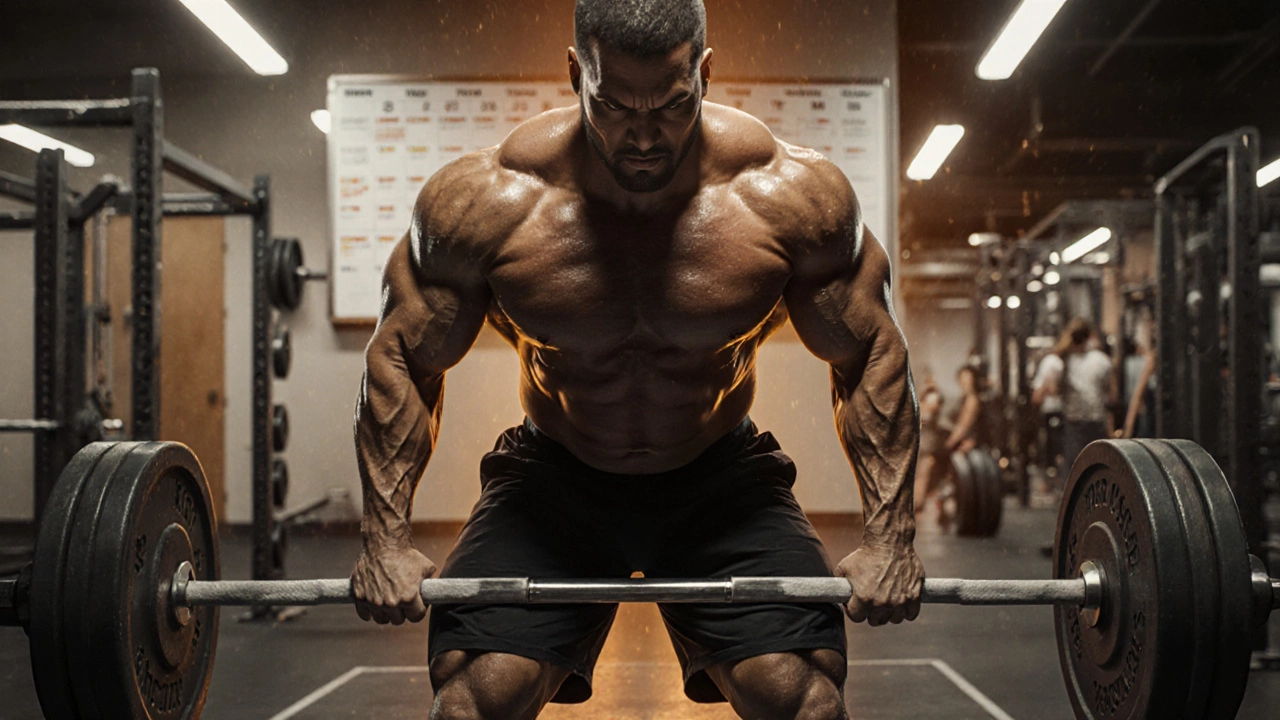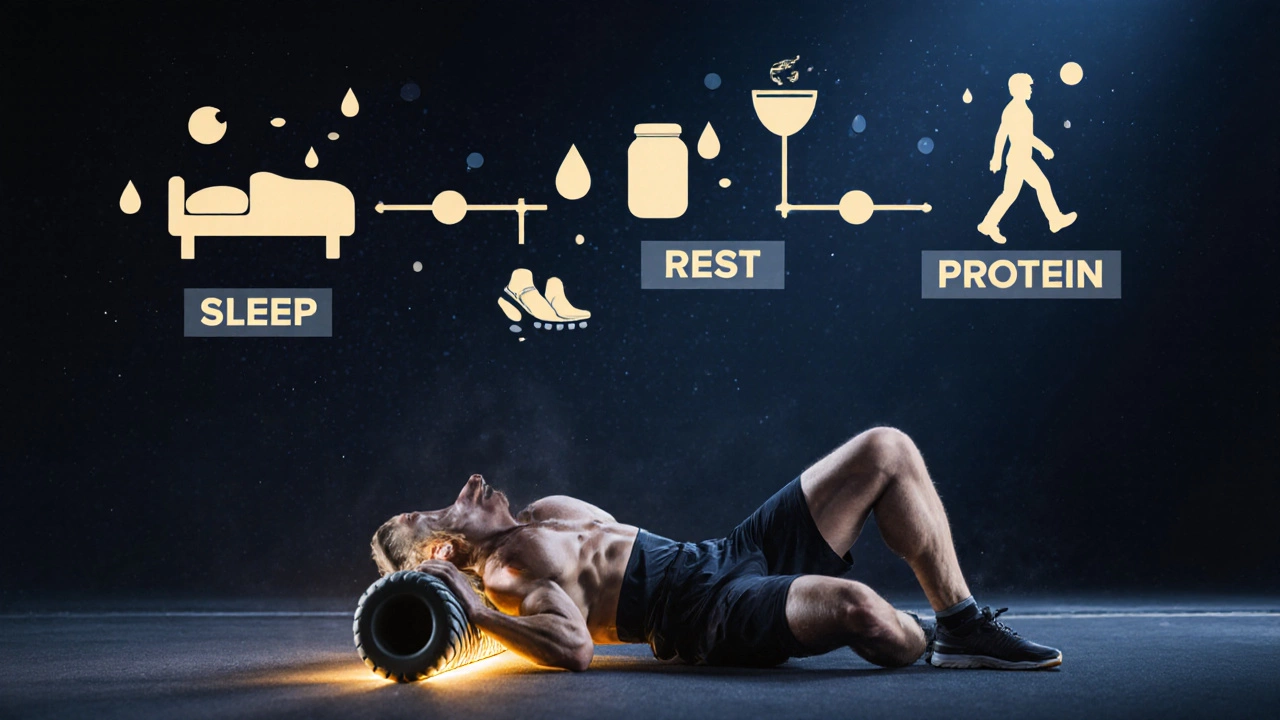Gym Schedule Planner
Your Recommended Schedule
Sample Weekly Plan
Trying to figure out what a good gym schedule looks like? You’re not alone. Most people start strong, hit a wall after two weeks, and quit because their plan didn’t match their life-not their goals. A good gym schedule isn’t about doing more. It’s about doing the right things at the right time, with enough rest to actually get stronger.
Start With Your Goal
Before you pick days or pick weights, ask yourself: Why are you going to the gym?
If you want to lose weight, you need movement and consistency. If you want to build muscle, you need progressive overload and recovery. If you want to get stronger for sports or daily life, you need functional strength and mobility. Your schedule changes based on your goal.
There’s no magic number of days. Some people thrive on five days a week. Others do just fine with three. What matters is whether you can stick to it for months, not weeks.
Beginner Gym Schedule (3-4 Days a Week)
If you’re new to lifting, your body doesn’t know how to recover from stress yet. Too much too soon leads to burnout, soreness that lasts a week, or worse-injury.
A simple split works best:
- Day 1: Full body (squats, push-ups, rows, planks)
- Day 2: Rest or light walk
- Day 3: Full body (deadlifts, overhead press, lunges, pull-ups)
- Day 4: Rest
- Day 5: Full body (focus on form, lighter weights)
- Day 6-7: Rest or mobility work
This gives you three solid sessions a week with enough rest in between. Each workout takes 45-60 minutes. You’re not trying to exhaust yourself. You’re teaching your body how to move, how to recover, and how to get stronger slowly.
Use bodyweight or light dumbbells at first. Master the squat before adding weight. Learn the hinge before deadlifting heavy. Your form matters more than the number on the bar.
Intermediate Gym Schedule (4-5 Days a Week)
Once you’ve been lifting for 6-12 months and can do 10 clean push-ups, 15 bodyweight squats, and hold a 30-second plank, you’re ready to split your training.
Most people at this stage use an upper/lower split or a push/pull/legs routine.
Here’s a clean upper/lower split:
- Day 1: Upper body (bench press, rows, shoulder press, biceps, triceps)
- Day 2: Lower body (squats, Romanian deadlifts, calf raises, glute bridges)
- Day 3: Rest or cardio
- Day 4: Upper body (pull-ups, dumbbell press, face pulls, rear delt flies)
- Day 5: Lower body (deadlifts, lunges, leg press, core)
- Day 6: Active recovery (yoga, walking, swimming)
- Day 7: Rest
This lets you train each muscle group twice a week-which is ideal for growth. You’re not doing 10 exercises per session. You’re doing 4-6 solid ones with good weight and control.
Track your lifts. Write down what you did last time. Try to add 2.5 kg to your squat or one more rep on your pull-ups each week. That’s progress.
Advanced Gym Schedule (5-6 Days a Week)
If you’ve been training seriously for over two years, you can handle more volume and frequency. But even then, recovery is still your limiting factor.
A common advanced routine is the push/pull/legs split, done twice a week:
- Day 1: Push (chest, shoulders, triceps)
- Day 2: Pull (back, biceps, rear delts)
- Day 3: Legs (quads, hamstrings, calves)
- Day 4: Rest
- Day 5: Push (different exercises, heavier weights)
- Day 6: Pull (focus on back thickness)
- Day 7: Legs (higher reps, burnout sets)
Notice you’re not training every day. You’re training five days, resting one, and doing light movement on the seventh. That’s enough. Many advanced lifters overtrain because they think more is better. It’s not.
At this level, you’re fine-tuning. Maybe you add a 10-minute core session after leg day. Or you do 15 minutes of mobility work on rest days. But you’re not adding another heavy squat session because you saw someone online do six days of squats.

Recovery Isn’t Optional
People think the gym is where they get strong. It’s not. The gym is where you break down muscle. You get strong when you sleep, eat, and rest.
Here’s what recovery looks like in practice:
- 7-8 hours of sleep every night
- 1.6-2.2 grams of protein per kg of body weight daily
- At least one full rest day per week
- Hydration: 3-4 liters of water, more if you sweat a lot
- Walking 8,000-10,000 steps on rest days
In Bangalore, where humidity and heat make recovery harder, skipping sleep or drinking too little water will sabotage your progress faster than skipping a workout.
What to Avoid
Here are the biggest mistakes people make with their gym schedule:
- Doing full-body workouts every day-your muscles don’t have time to rebuild
- Training abs every day-your core needs rest like any other muscle
- Skipping warm-ups because you’re “in a hurry”-injury risk spikes
- Only doing cardio-cardio is great, but it won’t build muscle or boost metabolism long-term
- Comparing your schedule to influencers-most of them use supplements, have coaches, or are genetically gifted
You don’t need to train like a bodybuilder to look good or feel strong. You need consistency, not intensity.
Adjust Based on Your Life
A good gym schedule fits your life-not the other way around.
If you work 9 to 7 and have kids, don’t try to go at 5 a.m. every day. Go at 7 p.m. three times a week. That’s better than quitting because you missed a Monday.
If your job is stressful, add two 10-minute breathing sessions on rest days. If you travel often, do bodyweight workouts in your hotel room. If you hate machines, stick to free weights and resistance bands.
Flexibility beats perfection.

Sample Weekly Plan (Based on Your Goal)
Here’s how to pick your plan:
| Goal | Days per Week | Focus | Rest Days |
|---|---|---|---|
| Weight loss | 3-4 | Full body + cardio | 3-4 |
| Build muscle | 4-5 | Upper/lower or push/pull/legs | 2-3 |
| Get stronger | 4-5 | Compound lifts, low reps | 2-3 |
| Stay active | 2-3 | Bodyweight, mobility, walk | 4-5 |
Choose one. Stick to it for 8 weeks. Then reassess.
When to Change Your Schedule
You don’t need to change your plan every month. But here are signs it’s time:
- You’re not getting stronger after 4 weeks
- You’re constantly tired or sore
- You dread going to the gym
- You’ve plateaued on all lifts
When that happens, don’t add more days. Try this:
- Reduce volume by 20% for one week
- Focus on sleep and protein
- Then, switch exercises-swap barbell squats for goblet squats, or bench press for dumbbell press
Small changes reset your body. Big changes break it.
Final Thought
A good gym schedule isn’t about fitting in the most workouts. It’s about creating a habit that lasts. One that you don’t have to force yourself to do. One that becomes part of your day, like brushing your teeth.
Start small. Stay consistent. Listen to your body. And remember-you don’t need to be perfect. You just need to show up.
How many days a week should I go to the gym?
It depends on your experience and goal. Beginners do well with 3 days a week. Intermediate lifters benefit from 4-5 days. Advanced trainees can handle 5-6, but only if they prioritize recovery. More isn’t better-consistency is.
Can I work out every day?
You can, but you shouldn’t train hard every day. Muscles grow when they rest, not when you lift. If you want to be active daily, use light walks, yoga, or mobility work on your off days. Save heavy lifting for 3-5 days a week.
Is a 3-day gym schedule enough to build muscle?
Yes, if you train hard and eat enough protein. Many bodybuilders started with 3 full-body days a week. The key is progressive overload-gradually lifting heavier or doing more reps. Frequency matters, but intensity and recovery matter more.
What should I do on rest days?
Rest days aren’t lazy days. Move gently: walk 6,000-10,000 steps, stretch, foam roll, or do yoga. Hydrate well and sleep 7-8 hours. This helps your muscles repair and prepares you for your next workout.
How long should each gym session last?
45-75 minutes is ideal. Longer sessions don’t mean better results. After 75 minutes, cortisol levels rise and recovery slows. Focus on quality over quantity. Five focused sets of squats are better than 20 rushed ones.
Should I do cardio with my gym schedule?
Yes, but keep it separate. Do 2-3 sessions of moderate cardio (brisk walking, cycling, swimming) on non-lifting days or after weight training. Don’t do long cardio before lifting-it drains energy you need for strength.
What if I miss a workout?
Skip the guilt. Just get back on track with your next scheduled session. One missed day won’t ruin progress. Missing three weeks will. Don’t try to make up for it by overtraining. Rest is part of the plan.





